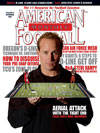AMERICAN FOOTBALL MONTHLY THE #1 RESOURCE FOR FOOTBALL COACHES
Article CategoriesAFM Magazine
|
The Drills Report - Teaching Linebackers Proper Techniqueby: Joe TumpkinLinebackers Coach, SMU © More from this issue Our base defense at SMU is the 4-3-4 alignment which allows our defensive package to include multiple fronts and coverages. With the variety and versatility of offenses today and the adjustments made defensively, it is important to be consistent in teaching techniques to your players. In this article I will focus on my strategy and teaching progression in developing linebackers. Strategy Coaches should have the ability to communicate with students, athletes, coaches and colleagues. Success in coaching relates to a willingness to prepare for success, regardless of barriers or obstacles. The development of an athlete has six elements: 1.Talent: Utilize it! Play to your strengths and manage your weaknesses. 2. Knowledge: Players need to have a sound understanding of what you are teachin....The full article can only be seen by subscribers. Subscribe today!
|
|
|||||||
| HOME |
MAGAZINE |
SUBSCRIBE | ONLINE COLUMNISTS | COACHING VIDEOS |
Copyright 2025, AmericanFootballMonthly.com
All Rights Reserved





